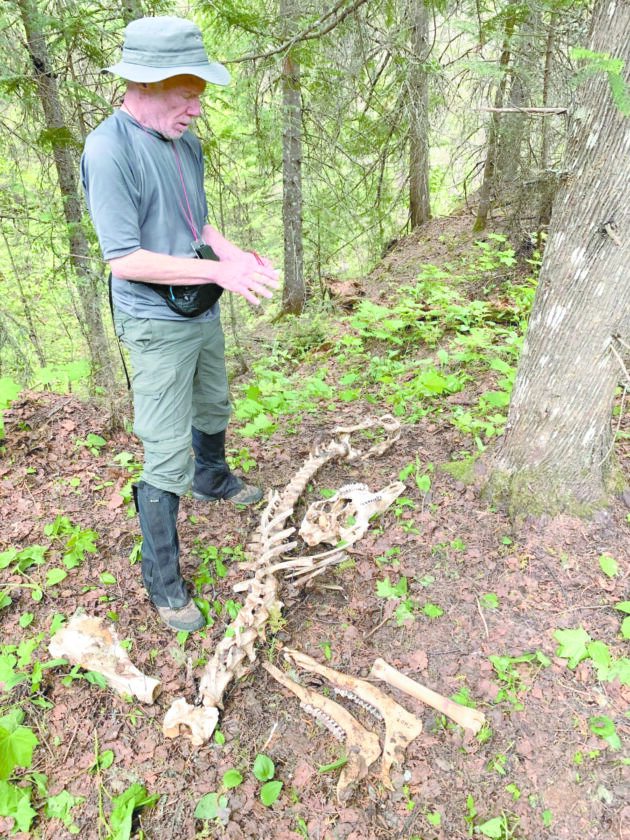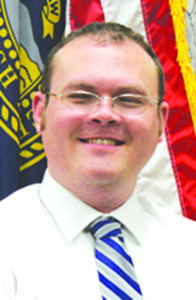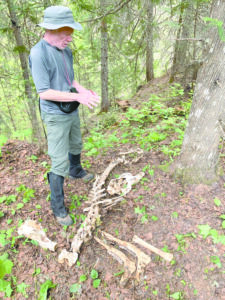‘Dig in and get my hands dirty’: New book explores citizen scientists and their contributions

Jeffery Holden is pictured taking notes over a wolf-killed moose on Isle Royale. (Photo courtesy of Anna Burke)
LANSING – Jeffrey Holden spends his summers knee-deep in dead moose.
In his new book “Dead Moose on Isle Royale: Off Trail with the Citizen Scientists of the Wolf-Moose Project” (Michigan State University Press, $24.95), Holden turns decades of volunteer field notes and short essays into an off-trail narrative about the people who sustain one of ecology’s longest-running studies.
The Wolf-Moose Project at Isle Royale National Park started with scientists from Purdue University, Durward Allen and L. David Mech, in 1958. Since then, volunteers have collected data through on-the-ground fieldwork and built a six-decade record that reveals how climate, disease and food availability shape population cycles.
It’s the world’s longest-running predator-prey study, tracking the balance between gray wolves and moose in the remote island national park in Lake Superior.
Isle Royale’s ecosystem is simple – wolves as the main predator and moose as the main prey – and the project shows the unique dynamic into how predator-prey relationships work in the wild.
“People thought wolves were relentless killing machines and that the moose were goners. It was quickly apparent to Allen and Mech that that presumption was incorrect. Wolves are selective and, more often than not, unsuccessful hunters,” Holden writes.
Holden first went to Isle Royale to volunteer for the Wolf-Moose Project in 2002 because he enjoys taking a vacation where he is learning and always doing something.
During that period, he helped the group leader butcher two rotting moose carcasses. Their goal? Retrieving the moose bones for scientific analysis.
“I think that kind of separated me from some of the other volunteers. I was willing to literally dig in and get my hands dirty,” said Holden.
For over the two decades that he has been traveling to Isle Royale to volunteer for the project, he wrote weekly essays and kept journals.
“I thought, ‘I’ve got enough material here for a book,'” Holden said.
A former data specialist in health care, he wrote the book for readers who are curious about field work rather than for specialists.
“I was writing for non-scientist people, and I wanted it to be kind of informal and conversational, so it’s not a technical sort of text,” Holden said.
He uses that conversational style to tell the story of a study that many scientists view as one of the world’s most important.
The preface is by Douglas Smith, the project leader of the Gray Wolf Restoration Project in Yellowstone National Park for nearly 30 years.
“The Isle Royale Wolf-Moose Study is pushing seven decades, and its contribution to understanding nature and predator-prey interactions is unrivaled,” Smith wrote.
“It has also utilized hundreds of enthusiastic and capable volunteers — people who want to make a difference. Together, these things have made this study perhaps one of the most important in the world,” he wrote.
Holden has seen that power firsthand, saying that the volunteers are what makes the project possible.
Usually, 60 to 80 volunteers join each summer and “constitute the majority of the summer study” by locating carcasses, taking photos and hauling remains back to the researchers.
That effort has created an unusually large archive of skeletal remains.
“The citizen scientists bring back a lot of moose skeletons. So right now the project has a little over 6,000 sets of moose remains from the last 50, 60 years of the project. And it’s a pretty comprehensive set of moose bones,” said Holden.
The book also explains the scientific advantage of decades of research.
Holden pointed to a recent collaboration with Duke University researchers in human medicine to compare moose health to human health.
“They were able to document a very strong correlation between periodontal disease and arthritis in general,” Holden said.
He also touches on the ethical and logistical pressures facing long-term research, including funding.
One of the project’s main grants from the National Science Foundation is likely to be reduced or cut entirely.
Holden said the project’s leaders helped start a foundation to build an endowment after concerns that government grants might decline.
“Depending on the year, it takes $150,000 to run this study,” he said.
Holden said long-term researchers often struggle to attract steady support because funders want quick results.
A part of what keeps Holden going are the connections he has made.
“There’s a lot of good friends now that I’ve got that go up and do the same thing. And we all have kind of the same mission, so it’s one of those shared experiences that makes the time richer,” Holden said.
Isabella Figueroa writes for Great Lakes Echo.





